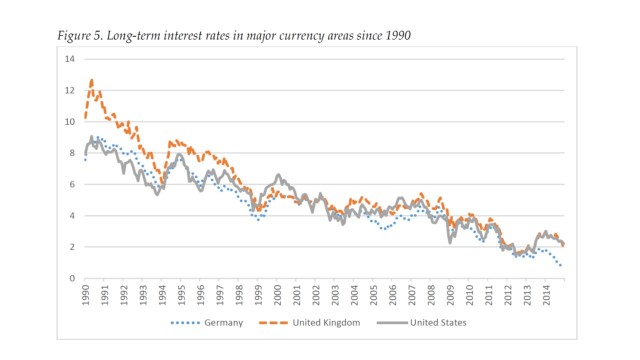The Fed’s stated purpose of quantitative easing (QE) was to lower long-term interest rates, and many papers have endeavored to test empirically whether it achieved that purpose. Some, such as the paper by Gagnon, Raskin, Remache, and Sack, have looked at the impact of QE announcements, finding the intended impact. Others have questioned estimates based on announcement effects because they may miss reversals that come after the initial effect; a paper by Stroebel and Taylor has instead looked at the direct cumulative effects of bond purchases during QE1, controlling for various risks, and they do not find a significant impact.
A recent study by Ansgar Belke, Daniel Gros and Thomas Osowski takes a whole new approach by controlling for global effects on long-term interest rates. They focus on QE1 and they find no significant impact. The paper was presented yesterday by Ansgar Belke at the Conference on Macroeconomic Analysis and International Finance in Crete, where I was the discussant
The basic idea is explained simply at the start of the paper using the following chart of the 10-year US Treasury rate along with comparable rates in Europe.
“Eyeball econometrics” reveals a lot of co-movement in these rates, which raises basic questions about the finding that changes in the US rate were due to QE. In fact, while the authors show that the US 10-year Treasury rate fell by 1.1 percentage points around the time of QE1—leading to the view that QE had the intended effects—it turns out that the long-term rate in the Euro area (measured by long-term German bonds) came down by about the same amount. Using rigorous statistical techniques, the authors find that QE1 has no significant effect on the long-term relationship between the interest rate differential and the exchange rate. Here they use co-integrated time series models with residual tests for structural breaks—modern versions of Chow tests.
This finding also raises doubts about some of the rationales for the effect of QE, including portfolio balance arguments, which would not be expected to have such large global effects. To be sure, it could be that QE1 had the signaling effect that short-term policy rates in the US would be lower for longer, and thereby signaled the same for the ECB policy rate assuming some kind of policy contagion. If so, term structure models might suggest co-movements in long-term rates in Europe.
Their model also includes the exchange rate, which will enable them or others to use the approach to examine exchange rate effects in other periods and countries, and perhaps estimate the effect of QE by the Bank of Japan and the ECB in 2012-2015, which eyeball econometrics suggest led to depreciation of the yen and then the euro.




